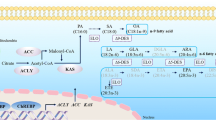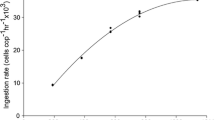Abstract
The calanoid copepod Calanus sinicus was reared in the laboratory under excess food conditions, and its development and growth rates were measured at various temperatures. Egg development time (DH, days) was dependent on temperature (T °C), and was expressed as DH = 55.3 (T + 0.7)−1.44. Post-embryonic development followed the equiproportional rule. The stage duration was short in NI and NII, but compensatingly longer in NIII. Between NIV and CII, it was nearly isochronal, and beyond CII, it tended to increase gradually. The time from egg to adult was expressed as DCVI = 1258 (T + 0.7)−1.44. The specific growth rate was also temperature-dependent and highest from CI to CIII, intermediate from NII to CI and from CIII to CV, and lowest from CV to CVI. The growth rates of C. sinicus are higher than those of co-occurring small copepods such as Paracalanus, Acartia and Microsetella.
Similar content being viewed by others
References
Brodsky, K. A., 1965. Variability and systematic of the species of the genus Calanus Copepoda. 1. Calanus pacificus Brodsky and Calanus sinicus Brodsky sp. n. Exp. Fauna Seas 3: 22–71 (In Russian, cited in Kidachi,1979a & b).
Corkett, C. J., 1984. Observations on development in copepods. Crustaceana (Suppl.) 7: 150–153.
Corkett, C. J. & I. A. McLaren, 1970. Relationships between development rate of eggs and older stages of copepods. J. mar. biol. Ass. UK 50: 161–168.
Corkett, C. J., I. A. McLaren & J.-M. Sevigny, 1984. The rearing of the marine calanoid copepods Calanus finmarchicus (Gunnerus), C. glacialis Jaschnov and C. hyperboreus Kröyer with comment on the equiproportional rule. Syllogeus 58: 539–546.
Frost, B. W., 1972. Effects of size and concentrations of food particles on the feeding behavior of the marine planktonic copepod Calanus pacificus. Limnol. Oceanogr. 17: 805–815.
Frost, B. W., 1980. The inadequacy of body size as an indicator of niches in the zooplankton. In W. C. Kerfoot (ed.), Evolution and Ecology of Zooplankton Communities. Univ. Press of New England, London: 742–753.
Hirota, R., 1964. Zooplankton investigation in Hiuchi-nada in the Setonaikai (Inland Sea of Japan). I. The seasonal occurrence of copepods at the three stations in Hiuchi-nada. J. Oceanogr. Soc. Japan 20: 24–31.
Hirota, R., 1979. Seasonal occurrence of zooplankton at a definite station off Mukaishima from July of 1976 to June of 1977. Publ. Amakusa mar. Biol. Lab. 5: 9–17.
Ikeda, T., 1974. Nutritional ecology of marine zooplankton. Mem. Fac. Fish., Hokkaido Univ. 22: 1–97.
Johnson, J. K., 1981. Population dynamics and cohort persistence of Acartia californiensis (Copepods Calanoida) in Yaquina Bay, Oregon. Ph. D. thesis, Oregon State University
Kidachi, T., 1979a & b. Systematics of Calanus in the Japanese waters, with special reference to morphological differentiations of Calanus in Sagami Bay. Kaiyou to Seibutsu 2: 9–15, 3: 25–31 (In Japanese).
Klein Breteler, W. C. M., H. G. Fransz & S. R. Gonzalez, 1982. Growth and development of four calanoid copepod species under experimental and natural conditions. Neth. J. Sea. Res. 16: 195–207.
Landry, M. R., 1975. The relationship between temperature and the development of life stages of the marine copepod Acartia clausi Giesbr. Limnol. Oceanogr. 20: 854–858.
Landry, M. R., 1978. Population dynamics and production of a planktonic marine copepod, Acartia clausii, in a small temperate lagoon on San Juan Island, Washington. Int. Revue ges. Hydrobiol. 63: 77–119.
Landry, M. R., 1983. The development of marine calanoid copepods with comments on the isochronal rule. Limnol. Oceanogr. 28: 614–624.
Lin, Y. & S. Li, 1984. A preliminary study on the life cycle of Calanus sinicus Brodsky in Xiamen Harbour. J. Xiamen Univ. (Natural Sci.) 23: 111–117 (In Chinese with English abstract).
Lynch, M., 1977. Fitness and optimal body size in zooplankton populations. Ecology 58: 763–774.
McLaren, I. A., 1978. Generation lengths of some temperate marine copepods: estimation, prediction and implications. J. Fish. Res. Bd. Can. 35: 1330–1342.
McLaren, I. A., 1986. Is ‘structural’ growth of Calanus potentially exponential? Limnol. Oceanogr. 31: 1342–1346.
McLaren, I. A. & C. J. Corkett, 1981. Temperature-dependent growth and production by a marine copepod. Can. J. Fish. aquat. Sci. 38: 77–83.
McLaren, I. A., C. J. Corkett & E. J. Zillioux, 1969. Temperature adaptation of copepod eggs from the arctic to the tropics. Biol. Bull. 137: 486–493.
Miller, C. B., J. K. Johnson & D. R. Heinle, 1977. Growth rules in the marine copepod genus Acartia. Limnol. Oceanogr. 22: 326–335.
Mullin, M. M. & E. R. Brooks, 1970. Growth and metabolism of two planktonic, marine copepods as influenced by temperature and type of food. In J. H. Steele (ed.), Marine Food Chains. Oliver & Boyd, Edinburgh: 74–95.
Peterson, W. T., 1986. Development, growth, and survivorship of the copepod Calanus marshallae in the laboratory. Mar. Ecol. Prog. Ser. 29: 61–72.
Uye, S., 1980. Development of neritic copepods Acartia clausi and A. steueri. II. Isochronal larval development at various temperatures. Bull. Plankton Soc. Japan 27: 11–18.
Uye, S., 1986. Impact of copepod grazing on the red-tide flagellate Chattonella antiqua. Mar. Biol. 92: 35–43.
Uye, S., H. Kuwata & T. Endo, 1986. Standing stocks and production rates of phytoplankton and planktonic copepods in the Inland Sea of Japan. J. Oceanogr. Soc. Japan 42: 421–434.
Vidal, J., 1980. Physioecology of zooplankton. I. Effect of phytoplankton concentration, temperature, and body size on the growth rate of Calanus pacificus and Pseudocalanus sp. Mar. Biol. 56: 111–134.
Author information
Authors and Affiliations
Rights and permissions
About this article
Cite this article
Uye, Si. Temperature-dependent development and growth of Calanus sinicus (Copepoda: Calanoida) in the laboratory. Hydrobiologia 167, 285–293 (1988). https://doi.org/10.1007/BF00026316
Issue Date:
DOI: https://doi.org/10.1007/BF00026316




